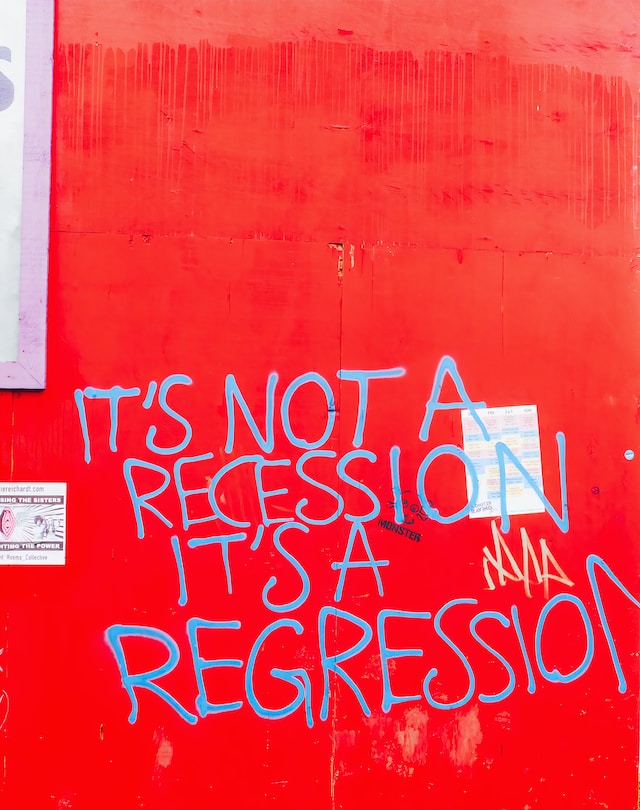As the global economy continues its recovery from the COVID-19 pandemic, concerns are mounting about the possibility of a recession in 2024 looming on the horizon.
With financial analysts and economists offering differing opinions on recession prediction, the question remains: is there going to be a recession in 2024? The market indicators definitely seem to suggest that way.
However, to better understand the potential risks and indicators, this article examines various factors, including fiscal and monetary policies, market indicators, and global economic trends.
Fiscal and Monetary Policies For Understanding Recession
One of the main drivers of economic growth is the fiscal and monetary policy set by governments and central banks. Expansionary policies, such as low-interest rates and increased government spending, can stimulate growth, while contractionary policies can lead to a slowdown.
The current low-interest-rate environment has encouraged companies and individuals to take on more debt, which could become unsustainable in the long term. As corporate debt levels rise, it could threaten global macroeconomic credit stability.
Central banks around the world have been implementing various measures to stimulate their economies, including quantitative easing (QE) programs.
If central banks decide to tighten monetary policy too quickly, it could lead to a sudden correction in asset prices, further increasing the risk of a recession. Many central banks, including the US Federal Reserve, the European Central Bank, and the Bank of Japan, have implemented quantitative easing (QE) programs to support their economies

While these measures have had positive short-term effects on asset prices and interest rates, some economists argue that such prolonged easy monetary policies could lead to asset bubbles.
These measures have led to an increase in asset prices and a decrease in interest rates. However, some experts argue that this prolonged period of easy monetary policy may have created asset bubbles, which could burst and trigger a recession.
Policymakers will need to strike a delicate balance between supporting economic growth and preventing the formation of asset bubbles. Otherwise, this could have severe consequences for the global economy.
Market Indicators for Understanding Recession
Market indicators can offer valuable insights into the future direction of the economy. Among these indicators, the yield curve is one of the most reliable predictors of a recession.
While the yield curve has historically been a reliable indicator of an impending recession, it is essential to consider other market indicators as well. Stock market valuations, for example, can provide insights into the overall health of the economy.
The cyclically adjusted price-to-earnings (CAPE) ratio, developed by Nobel laureate Robert Shiller, measures the stock market’s valuation relative to its historical average. A high CAPE ratio suggests that stocks are overvalued and could be vulnerable to a significant correction.
As of late 2022, the CAPE ratio has been hovering above its historical average, which could signal an increased risk of a market downturn. Historically, an inverted yield curve, where short-term interest rates are higher than long-term interest rates, has preceded every US recession since the 1960s.
In 2019, the yield curve inverted briefly, sparking fears of an imminent recession. However, the recession did not materialize, and the curve has since returned to normal. As of now, the yield curve does not show any signs of inversion, suggesting that a recession in 2024 is not imminent based on this market indicator alone.
Global Economic Trends for Understanding Recession
Economic trends across the globe can also provide clues about the likelihood of a recession in 2024. For instance, the strength of the US dollar, the state of the European and Asian economies, and the ongoing trade tensions between major world powers can all influence the global economic outlook.
In addition to monitoring the strength of the US dollar, it is crucial to keep an eye on economic developments in other regions of the world, as their performance can impact the global economy. The European and Asian economies, for instance, have experienced significant challenges in recent years, which could contribute to the likelihood of a recession in 2024.

In Europe, the ongoing Brexit negotiations have created uncertainty for businesses and investors, potentially hampering economic growth. Furthermore, political instability in various European countries could undermine the unity and effectiveness of the European Union. This could further exacerbate the region’s economic challenges.
The US dollar index (DXY), which measures the value of the dollar against a basket of other major currencies, has experienced significant fluctuations in recent years. A stronger dollar can hurt US exports, leading to slower economic growth.
However, the dollar has been relatively stable lately, suggesting that it is not currently a significant risk factor for a recession. In Europe, the ongoing Brexit negotiations and the potential for further fragmentation within the European Union could impact the region’s economic stability.
Asia, on the other hand, has been a significant driver of global growth, with China’s economy expanding rapidly. However, the escalating trade tensions between the US and China could have adverse effects on global economic growth, potentially increasing the risk of a recession.
In Asia, the recent economic slowdown in China has raised concerns about the health of the global economy. While China’s growth rate remains relatively high compared to other countries, a more significant slowdown could have a ripple effect on the world economy, increasing the likelihood of a recession.
The Role of Corporate Debt in Determining Recession
Another factor to consider is the level of corporate debt, which has been rising steadily since the global financial crisis in 2008. High levels of corporate debt can make companies more vulnerable to economic downturns, increasing the risk of a recession.
Global corporate debt has reached record levels in recent years. This increased debt burden can make companies more vulnerable to economic downturns, potentially leading to a recession.
A study by the International Monetary Fund (IMF) found that approximately 40% of corporate debt in major economies could be at risk in the event of a significant economic slowdown. Furthermore, companies with high levels of debt could face difficulties refinancing their obligations if credit markets tighten, potentially leading to a wave of corporate defaults that could trigger a recession.
According to the International Monetary Fund (IMF), global corporate debt reached a record high of $83 trillion in 2020. While low interest rates have made it cheaper for companies to borrow money, excessive debt levels can lead to financial instability.
As companies struggle to service their debt in the face of an economic slowdown, the increased vulnerability could contribute to the likelihood of a recession in 2024.
Technological Disruption and Job Market
Another factor to consider when assessing the likelihood of a recession in 2024 is the impact of technological disruption on the job market. Rapid advancements in automation, artificial intelligence, and robotics have the potential to displace a significant number of jobs across various industries. This could end up leading to higher unemployment rates and decreased consumer spending.
According to a study by the World Economic Forum, approximately 85 million jobs could be displaced by automation by 2025. While new technologies are expected to create 97 million new jobs, the transition process could be challenging, especially for workers who lack the necessary skills to adapt to the changing job market.

This shift in the labor force could result in short-term economic instability and contribute to the risk of a recession.
Geopolitical Risks
Geopolitical risks, such as international conflicts, trade disputes, and political instability, can significantly impact global economic growth and increase the likelihood of a recession.
These risks can lead to increased uncertainty in financial markets, reduced international trade, and disruptions to the global supply chain.
The ongoing trade tensions between the United States and China have already had an impact on global economic growth. Additionally, conflicts in the Middle East and other regions can lead to disruptions in the global oil supply, which can cause volatility in energy prices and negatively impact the economy.
It is crucial for governments and international organizations to work together to mitigate these risks and foster a stable geopolitical environment conducive to economic growth.
Demographic Changes
Demographic trends, such as aging populations and declining birth rates, can also influence the likelihood of a recession in 2024. An aging population can lead to a shrinking workforce, reduced productivity, and increased pressure on social welfare systems.
According to the United Nations, the global population aged 65 and over is projected to double by 2050, reaching 1.5 billion. This demographic shift could result in slower economic growth and increased fiscal burdens on governments as they struggle to fund pensions and healthcare systems.
Furthermore, declining birth rates in many developed countries could exacerbate these challenges and contribute to the risk of a recession.
Climate Change and Environmental Risks
Climate change and environmental risks pose another significant threat to the global economy. The increasing frequency and severity of extreme weather events, such as hurricanes, floods, and wildfires, can result in significant economic losses and disrupt global supply chains.
A study by the Global Commission on the Economy and Climate estimates that the potential economic losses from climate change could reach $1 trillion per year by 2030.
These losses could strain government budgets, increase insurance costs, and reduce investor confidence, potentially contributing to the likelihood of a recession in 2024.
Conclusion
Assessing the probability of a recession in 2024 requires a comprehensive analysis of various economic, social, and environmental factors. While some indicators suggest potential risks and vulnerabilities, the inherent uncertainty in economic forecasting makes it impossible to predict with certainty whether a recession will occur.
Policymakers, businesses, and investors should remain vigilant and adaptable, prepared to navigate the complexities of the global economy in the coming years. By addressing the challenges posed by technological disruption, geopolitical risks, demographic changes, and climate change, we can build a more resilient and sustainable economic future.

